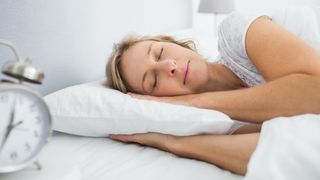How to choose a mattress that suits your sleeping position
Here we walk you through how to choose a mattress based on the way you like to sleep

When it comes to learning how to choose a mattress, the position you feel comfy enough to fall asleep in is a key factor. Get this right and you’ll quickly narrow down the very best mattress for you.
There are three common sleep positions – front, back and side. In terms of health, they all have their pros and cons, and we dig into those more in our articles exploring if side sleeping is good for you, if back sleeping is good for you, and if stomach sleeping is good for you. There are also people who switch positions during sleep, known as combination sleepers.
Each position needs support in a slightly different way, and it’s crucial that your mattress keeps your spine aligned however you sleep. Here look at how to choose a mattress that supports the position you enjoy snoozing in best.
How to choose a mattress for better sleep
Things to consider when choosing a mattress for your sleep position include firmness and the materials used. Because your sleeping position puts pressure on certain parts of your body, it’s important that the mattress firmness doesn’t throw your spine out of alignment.
For instance, side sleepers will place more pressure on the side of their hips and shoulder, so the best mattresses for side sleepers need to provide plenty of cushioning around the shoulders and hips. Front sleepers need to make sure their stomachs don’t dip too much, as that will throw their spine out of alignment and lead to aches and pains.

A way to gauge the correct firmness for you is to lie on your back. If you can slide your hand under the small of your back fairly easily, then it’s just right. If the gap is larger and your hand goes through too easily, the mattress could be too hard for you. Or if it’s a struggle to get your hand through, then it could be too soft. The same applies if you sleep on your front.
If you’re a side sleeper, you should be able to feel the mattress from your ribs to your pelvis. If you can’t, then it could be too firm. But if you’re sinking in and can feel pressure on your hips, then it could be too soft for your body in that position.
Get daily insight, inspiration and deals in your inbox
Sign up for breaking news, reviews, opinion, top tech deals, and more.
Here we’ve put together an at-a-glance guide highlighting what to look out for when choosing a mattress for your sleeping position:
| Sleep position | Main pressure points affected | Recommended firmness | Recommended mattress type |
| Side | Shoulders, hips, knees | Medium | Latex, memory foam, hybrid |
| Front | Head, shoulders, knees | Medium-firm, firm | Innerspring, hybrid |
| Back | Head, shoulder blades, sacrum, heels | Medium-firm, firm | Hybrid, latex |
| Combination | Any of the above | Medium | Latex, memory foam |
What are the main sleeping positions?
The most common sleeping position for adults is on the side of the body, whether that’s curled up in the foetal position or stretched out with arms extended. Sleeping on your side is helpful if you have gastric problems or are prone to snoring. It’s also good for healthy blood flow around the body. A stacked (not twisted) side sleeping posture can be one of the healthiest and most comfortable sleeping positions.
Make sure you are not resting on your arm in this position though, as that can impede circulation. Side sleepers should also be wary of pressure points by making sure their hips, shoulders and neck have enough cushioning.

Stomach sleepers often find it easier to breathe when they sleep on their front, plus it can help with sleep apnea problems. But, it can also put pressure on internal organs, not to mention the head and neck, which will need to twist in order to lay flat on the pillow. If you sleep hot, then it’s also probably best to avoid this position too, as it can be stifling.
Sleeping on your back is a good option if you want to maintain a neutral spine. It’s also another good option if you have digestive problems or acid reflux. However if snore, you might notice that sleeping on your back makes this worse.
How do sleeping positions affect mattress choice?
If you tend to wake in the night or you shift around trying to get comfy, then it could be that you need to adjust the firmness of your mattress. If you wake with sore pressure points, then your mattress is likely too firm. If you wake with a stiff back and neck, then it could be too soft and not supporting your spine properly.
If you’re not sure which firmness to go for, a medium firmness of 6.5 out of 10 is a good starting point. For heavier bodies, a firmer mattress might suit you better, while lighter sleepers could choose something softer.
Here we look at how to choose a mattress based on the most common sleeping positions, and we'll recommend some options to check out too.

How to choose a mattress for combi sleepers
If you switch sleeping positions during the night, your mattress needs to support you whether you’re on your side, front or back. A medium-firm option with a softer top (as found in hybrid mattresses), is a good choice to keep your spine in position and pressure points cushioned.
For solo combination sleepers, latex models have a higher response, meaning they bounce straight back as you switch position. Memory foam is also a good choice for combination sleepers, especially if you share a bed as it offers good motion isolation, so you shouldn't wake your partner so easily when moving around.
Innerspring mattresses tend to have poorer motion isolation and pressure relief. They can also be the noisiest depending on the type of spring.
How to choose a mattress for side sleeping
Side sleeping is the most common position for adults. In this position, a mattress that's too soft can cause your shoulder and hip to dig in and throw your spine out of alignment. But if it's too firm it can cause soreness on these same pressure points.
Ideally, your mattress will have enough support at the core or foundation, with a slightly softer top to provide enough cushioning for those pressure points. As mentioned earlier, the best mattress firmness for side sleepers is typically medium to medium-firm, with body type playing a key role in determining which end of the scale you fall. Those with an average to heavier build typically need something a little firmer, while those with a lighter build might do better on a medium mattress.
Having the right pillow for side-sleeping is also crucial – this should be slightly firmer and able to keep your neck aligned with your spine. If you have broad shoulders, look for a taller pillow or one where you can add extra filling.
How to choose a mattress for back sleepers
If you sleep on your back, your hips and shoulders need to be supported. With this sleeping position, the mattress firmness depends on the weight of the sleeper. Heavier frames need a firmer mattress and lighter sleepers might need a softer one. If you co-sleep, look out for a medium-firm option.
Features such as zoned support will help back sleepers stay aligned, all along their spine. Latex and hybrids are particularly effective for keeping your body supported from top to toe, without the middle of your body sinking in.
Try a medium-height pillow to lift your head and keep it aligned with the neck and shoulders without too much strain or any awkward angles. If you need extra support, you could also try placing a thinner pillow under your knees.

How to choose a mattress for stomach sleepers
If you mainly sleep on your stomach it’s very important to find the right mattress, as this position provides the least support for the back and can move the neck out of alignment with the spine.
A firmer mattress is recommended here because it keeps your spine straight. If your bed is too soft, your stomach and hips will sink in, placing strain on the back.
Choose a medium to medium-firm mattress and use a thinner pillow, as anything loftier will position your head too high. Latex models provide plenty of pressure relief without too much sinkage.
Innerspring and hybrid mattresses are also good at keeping the body in balance without any dips around the stomach area. If you have a smaller frame or are lighter in weight, you might prefer a medium firmness as firm might be too uncomfortable.
Grace Franks is an experienced sleep and mattress writer who has written for our sister sites Tom's Guide and T3, among other brands. She's interested in organic and eco-friendly sleep products, and how good sleep can improve our general wellbeing. When not writing about mattresses, Grace loves reading, creative writing, and practicing yoga.
Most Popular
